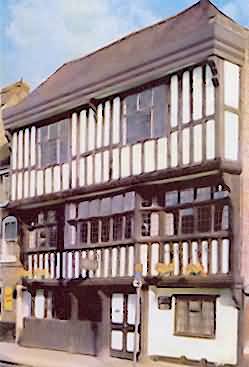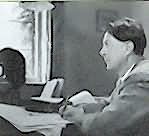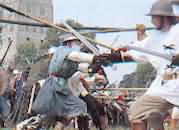| Check Out Lastminute on Accommodation |
Tewkesbury Museums, John Moore and the Battle of Tewkesbury |
|
| YOU ARE HERE: Tewkesbury Home Page > Museums | E-mail This Page |
|
|
|
|||||||||||||||
|
|||||||||||||||
|
|||||||||||||||
The Battle of Tewkesbury in the War of the Roses 1471 |
|||||||||||||||
|
The Wars of the Roses, a series of campaigns from 1455 to 1487, began as a struggle to rule England in the name of the incompetent Henry VI between the rival families of Lancaster and York. Later they became a fight for the crown itself. In 1470 the Yorkist Edward IV seemed secure on the throne but his great supporter, the Earl of Warwick, the `Kingmaker', quarrelled with him and joined Margaret of Anjou, Henry VI's queen. Caught off guard, Edward fled abroad and Henry VI was briefly restored. In March 1471 Edward landed at Ravenspur on the Yorkshire coast and advanced to London. Warwick pursued him and the two sides met at Barnet on Easter Sunday, 14 April, where the Lancastrians were defeated and Warwick killed. Meanwhile, Margaret and her son Edward, Prince of Wales, had raised a handful of troops in France and landed at Weymouth on the very day of Warwick's defeat, hearing the news the following day. Should she retreat to France or advance boldly to seek support to defeat her implacable enemies? Adopting the latter plan she gained the support of the Duke of Somerset and the Earl of Devonshire, advancing northwards to link up with her Welsh supporters under Jasper Tudor, Earl of Pembroke. At Bristol she was joined by more volunteers and raised funds and some artillery. Continuing north, she aimed to cross the Severn into Wales. The nearest bridge was at Gloucester and the next at Upton, though there was a deep ford at Lower Lode, Tewkesbury. Meanwhile Edward IV reassembled his victorious army and sent messengers ordering the citizens of Gloucester to close their gates against the Lancastrians. Without time to storm the city walls, Margaret marched on to Tewkesbury pursued by Edward. On the night of 3 May the Lancastrians camped just south of Tewkesbury with Edward two miles away at Tredington. Margaret dared not risk being caught with her forces divided to cross the river so her troops deployed in battle order on the higher ground, probably around Gupshill Manor.
Early next morning, Saturday, 4 May 1471, the Yorkists moved into position along the ridge from Southwick Park through Stonehouse Farm. The battle opened with an artillery exchange and a flurry of arrows. Somerset, on the Lancastrian right, advanced to outflank his opposite number, the Duke of Gloucester, later Richard III. Somerset did not know that Edward had sent 200 cavalry to search the wooded area of Tewkesbury Park. These `lances' now hurtled down the hill to take Somerset's men in the flank. The Lancastrian right retreated in disorder. Somerset blamed Lord Wenlock who commanded the Lancastrian centre for not supporting him and, according to some sources, beheaded him in front of his own men. The Lancastrians now fled in panic, large numbers being killed in the `Bloody Meadow' and trying to cross the River Swilgate. Prince Edward was killed in the retreat, together with John Beaufort, Somerset's brother. Other prominent Lancastrians took refuge in the Abbey, including Somerset and John Langstrother, Prior of St John. The Yorkists violated the sanctuary of the church and the Lancastrian leaders were summarily tried and executed, probably at the Crescent. Several Lancastrians were buried in the Abbey, notably Edward, Prince of Wales, whose tomb is beneath the main tower from which the sun of York shines down on him. George, Duke of Clarence, a brother of Edward IV, who fought on the Yorkist side and who later reputedly drowned in a butt of Malmsey wine, also has a famous vault in the Abbey. Queen Margaret, after spending a night at Payne's Place, Bushley, was arrested, probably at Little Malvern Priory, and forced to enter London on 21 May with the victorious Edward IV That night her husband, Henry VI, was murdered in the Tower where she herself was imprisoned for several years before being ransomed by her father, the King of France. Edward ruled peacefully and powerfully until his death in 1483. The Yorkists then quarrelled among themselves, enabling the Lancastrian Henry Tudor, Earl of Richmond, to win the throne from Richard III on Bosworth Field in 1485 and to survive a final Yorkist thrust at Stoke in 1487. The victims of the battle are still remembered in an annual communion service in the Abbey on 4 May.
|
|||||||||||||||
Tewkesbury Museums, John Moore and the Battle of Tewkesbury |
|||||||||||||||
| This page last modified Tuesday, 28-May-2019 11:32:24 CEST | |||||||||||||||




